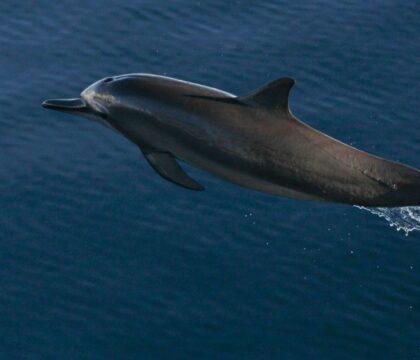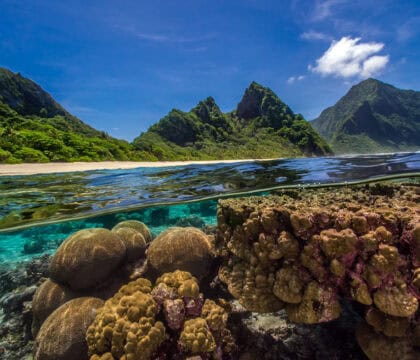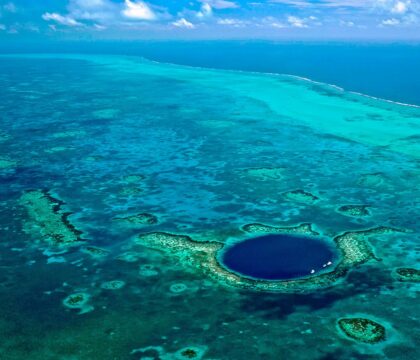September 20, 2024 • Travel Ideas
Perhaps we watch whales because we already know that we are not alone in the universe. That we do not need to look to the stars in search of sentient life. That, instead, we already share a home with species that exhibit sophisticated cultures, complex emotions, unique lingual dialects, and even similar brain cells to humans. Perhaps that is why we are drawn to the gray whales of Baja California, where they are seemingly as curious about us as we are them.
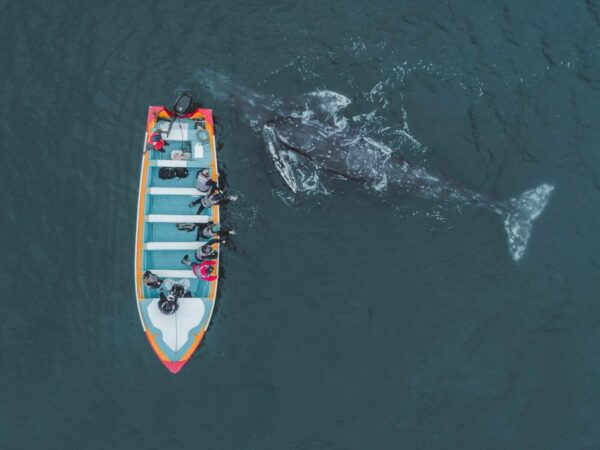
The gray whales of San Ignacio Lagoon are famously curious and friendly, often gliding gently alongside whale watching skiffs.
Though over 10 species of whales visit Baja California each year, making it one of the best regions in the world for whale watching, Baja is perhaps most famous for whale watching in San Ignacio lagoon, where a unique clan of gray whales regularly enjoy socializing with humans—a phenomenon only known to occur in three quiet coves on the Pacific coast of Baja. Their outgoing and ‘friendly’ behavior is especially remarkable when you consider that just a century ago they were hunted to near extinction in these very same lagoons.
Overcoming a Dark History
Each year, more than 3,000 Pacific gray whales embark on one of the longest known migrations made by a mammal: they swim over 12,000 miles from their Arctic feeding grounds off the coast of Alaska down to the quiet coves tucked on the Pacific coast of Baja California. Here, they mate, give birth, and nurse their calves in the buoyant and shallow waters – an ideal environment to build strength for the journey back north.
During this time, many of the gray whale moms will bring their newborn calves to brush alongside whale watching skiffs. They’re known to float gently alongside whale watchers, lift their heads above water, and to seemingly ask passengers to stroke their bodies – an experience that often brings people to tears and fuels a profound sense of connection.
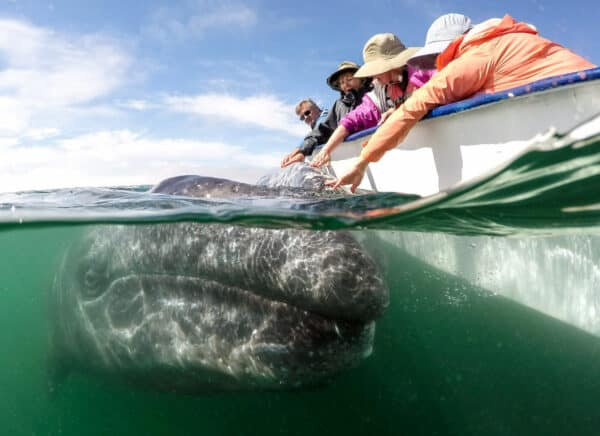
A gray whale brushes gently alongside a whale watching skiff with Oceanic Society travelers, seemingly inviting human touch. © José Sanchez
This is the only region in the world where gray whales are known to be so friendly, a behavior that baffles marine biologists. The tendency is seemingly cultural, and has become a ritual passed down from mothers to their calves, down through the generations.
What makes this phenomenon most surprising is that not only are gray whales famously protective of their young—leading whalers to deem them “devil fish”—but also that people had previously hunted gray whales to near-extinction. Before international bans on whaling were implemented in the 1940s, San Ignacio lagoon was not a safe-haven for whale watching, but rather a butchery.
But that relationship is a far cry from the gentle friendship the gray whales of Baja California now enjoy with humans, where in some cases they are even thought to ’ask’ humans to groom them.
Today, gray whales are protected by international and national laws that are strictly enforced by the Mexican government. Their population has rebounded to pre-whaling levels, a rare success story for a species that was on the brink of extinction.

Responsible Tourism Can Support Healthy Oceans
Stories like those of the gray whales of San Ignacio Lagoon—in which a community’s relationship with the ocean was transformed from wildlife extraction to wildlife tourism—highlight the purpose of Oceanic Society’s expeditions program: to create life-changing adventures that are meaningful for travelers and good for the ocean. Tourism, when done ethically, has the power to deepen our sense of connection to the environment, motivate behavior changes that support conservation, and reshape economies to support vulnerable ecosystems rather than plunder them.
The economy of Baja California today is a far cry from depending on whale blubber. Whale watching in Baja California is now considered one of the top wildlife experiences in the world, and it brings a sustainable source of foreign revenue and seasonal local employment to an area with otherwise limited options. Since 1993, San Ignacio Lagoon has been part of the largest nature reserve in Latin America, El Vizcaino Biosphere, a UNESCO World Heritage site, and is a model championed by environmental scientists. Whale watchers and tour operators throughout the gray whale migration pathway, from California to Alaska, also benefit from Mexico’s efforts to conserve gray whales and protect their habitat.

Beyond reshaping economies, protecting gray whales helps preserve the health of ocean ecosystems. Gray whales feed off the bottom of the ocean, and their feces naturally spread nutrients across the surface, supporting the growth of phytoplankton: the bedrock of the marine food chain. Without abundant phytoplankton, much of ocean life would suffer.
Gray whales are sensitive creatures, and though they often seek out human connection in the lagoons of Baja, such interactions must be on their terms. Mexican regulations mean that only licensed boats are allowed into the nursing grounds of San Ignacio Lagoon or Ojo de Liebre. Tour operators must not chase gray whales to not disrupt their important nursing time before they embark on the long journey back to the Arctic, when every bit of energy will be required. If an operator is caught ignoring the rules, they can lose their license.
Oceanic Society has led sustainable and ethical whale watching trips to San Ignacio Lagoon (and the nearby Sea of Cortez) for more than 50 years. When you travel with Oceanic Society, you help provide communities an alternative income to resource extraction, changing the economic landscape for generations and protecting species that are essential to the ecosystem.
Additionally, by simply signing up, each traveler directly sponsors the removal of 200 pounds of ocean plastic pollution and supports our ocean conservation mission.


